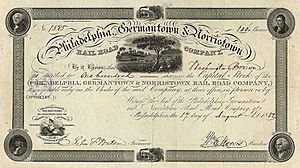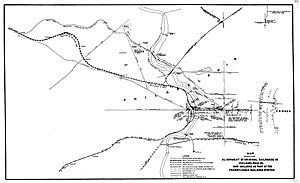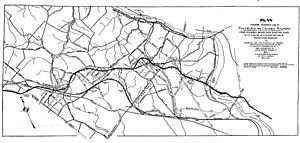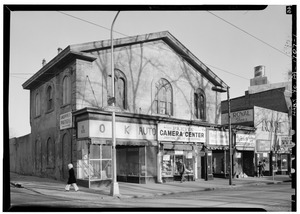History of rail transport in Philadelphia facts for kids
Philadelphia quickly became a very important center for railroads. Train lines from many different places met in this busy city. These railroads helped people and goods travel across Pennsylvania and beyond. They played a huge role in making Philadelphia a major city.
Contents
The First Railroads in Philadelphia
The very first railroad in Philadelphia was the Philadelphia, Germantown and Norristown Railroad. It opened in 1832 and ran north to a neighborhood called Germantown. This was an exciting new way to travel!
Soon after, in late 1833, another important railroad opened. This was the state-built Philadelphia and Columbia Railroad. It was part of a bigger transportation system called the Main Line of Public Works. This railroad helped connect Philadelphia to areas west of the city. It was built to make sure Pennsylvania didn't lose trade to other states, especially because of projects like the Erie Canal in New York.
At the same time, a north-south train line called the Philadelphia City Railroad also opened. It ran south along Broad Street from where the Philadelphia and Columbia Railroad ended.
Connecting the City and Beyond
More railroads quickly appeared, connecting different parts of Philadelphia and linking it to other cities.
Early Connections (1834-1838)
- In 1834, the Northern Liberties and Penn Township Railroad opened. This line connected the Philadelphia and Columbia Railroad to the Delaware River, just north of downtown.
- Later that same year, the Southwark Rail-Road opened. It connected the southern end of the City Railroad to the Delaware River.
- The Philadelphia and Trenton Railroad also started running in late 1834. It went north to Trenton, New Jersey.
- Another major line, the Camden and Amboy Railroad, also opened in 1834. This railroad started in Camden, New Jersey, crossed the Delaware River, and went all the way to South Amboy. From there, you could connect to New York City by crossing Raritan Bay. The Philadelphia and Trenton Railroad tried to get closer to downtown Philadelphia but couldn't. This made the Camden and Amboy Railroad the main way to reach Philadelphia from New Jersey for many years.
In 1837, the Philadelphia City Railroad extended its line east along Market Street to the Delaware River at Dock Street.
The Philadelphia, Wilmington and Baltimore Railroad opened in 1838. It reached Grays Ferry first, and later that year, it connected to downtown Philadelphia. It did this by using the Southwark and City Railroads.
Expanding West and North
The Philadelphia and Reading Railroad began operating in 1839. It used the Philadelphia and Columbia and City Railroads to get its trains into downtown Philadelphia.
In 1847, a branch of the Philadelphia and Trenton Railroad opened to Tacony. This allowed people to transfer to steamboats at Tacony to reach downtown Philadelphia by water.
Railroad Changes and New Lines
Railroads were always changing and growing to serve more places and improve travel.
Route Changes and New Companies
- In late 1850, the Philadelphia and Columbia Railroad changed its route. This new path helped trains avoid a steep incline called the Belmont Plane. Soon after, the City Railroad also extended its western line to meet this new route.
- In 1851, the old route of the Philadelphia and Columbia Railroad closed. The eastern part of this old route, which only the Philadelphia and Reading Railroad used, was sold to them.
In 1853, the West Chester and Philadelphia Railroad opened. It headed southwest and west towards West Chester. Two years later, in 1855, the first part of the North Pennsylvania Railroad opened. This line would eventually go north to Bethlehem.
A new path for the Philadelphia, Wilmington and Baltimore Railroad opened in 1872. The old route was then leased in 1873 to the Philadelphia and Reading Railway. In 1886, the Baltimore and Philadelphia Railroad opened. This gave the Baltimore and Ohio Railroad its very own way to get into Philadelphia.
Connecting the Major Lines
- The Junction Railroad opened in two parts, in 1863 and 1866. This railroad connected the different train lines located west of downtown Philadelphia.
- The Connecting Railway opened in 1867. This was very important because it connected the train lines north of downtown. It finally gave the Philadelphia and Trenton Railroad a direct route into downtown Philadelphia.
Eventually, most of the railroads going into Philadelphia were owned by two very large companies: the Pennsylvania Railroad or the Philadelphia and Reading Railway. The only exception was the Baltimore and Ohio Railroad's Baltimore and Philadelphia Railroad.
The Schuylkill River and Coal Transport
The Schuylkill River starts far away in Schuylkill County, Pennsylvania, near Pottsville, Pennsylvania. In the early days, this river was very important for transporting anthracite coal. This hard coal was shipped by mule on the Schuylkill Canal all the way to Philadelphia to be used as fuel.
Later, the Reading Railroad (also known as the Reading Company) became the main way to ship anthracite coal from the Coal Region. The Reading Railroad was a big competitor to the Pennsylvania Railroad. It built its tracks right along the Schuylkill River to carry the coal. Even today, coal is still shipped by train from Schuylkill County down to the ports of Philadelphia. The city of Reading, Pennsylvania, became a very wealthy town during the Industrial Revolution because it was a key stopping point for coal coming from the Coal Region.





